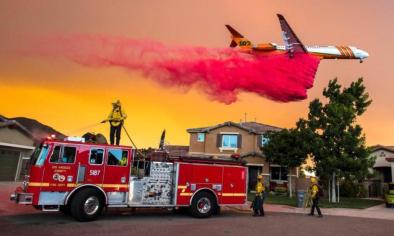The common thread in California's wildfires: heat like the state has never seen

The northern Sacramento Valley was well on its way to recording the hottest July on record when the Carr fire swept into town Thursday.
It was 113 degrees, and months of above-average temperatures had left the land bone-dry and ready to explode. Within a few hours, hundreds of structures were lost and six people killed.
The destruction adds to California’s worst wildfire year on record — dozens dead since October, with more than 10,000 structures lost from San Diego to Redding.
There are many reasons for the grim totals, but experts say one common denominator connects the disastrous fires: California is facing extreme heat, the likes of which it has never seen in the modern historical record.
“The temperatures have just been almost inexorably warmer all the time,” said UCLA climate scientist Daniel Swain, and fires “burn more intensely if the fuels are extremely dry.”
In the past, there has been some reluctance among scientists to cite climate change as a major factor in California’s worsening wildfires. Human-caused ignitions and homes being built ever closer to forests have played a large role. But the connection between rising temperatures in California and tinder-dry vegetation is becoming impossible to ignore, according to experts who study climate and wildfires.
“The regional temperatures in the western U.S. have increased by 2 degrees since the 1970s,” said Jennifer Balch, director of Earth Lab at the University of Colorado, Boulder. “You’re seeing the effect of climate change.”
Neil Lareau, assistant professor of atmospheric sciences at the University of Nevada, Reno, said unusual warmth is now routine, and that heat “leads to drying things out quicker.”
Vegetation can have various degrees of dryness — a wet log in the woods could smolder before puttering out, while tinder-dry chaparral on a 110-degree day could explode when ignited, Swain said. Extremely flammable vegetation can create a particularly intense fire with the potential to grow much faster — leaving less time for firefighters to get a handle on a blaze and for people to escape.
“What that means is the fire has to do less work to ignite the vegetation right next to it. And it can spread faster, and it releases energy more quickly,” Lareau said.
...
According to Swain, an ominous warning sign before each of the major fires of the last year — including last fall’s catastrophic Santa Rosa blaze — was alerts about record or near-record dryness in the vegetation.
The effect of temperature — and how dry the vegetation is — can matter more than how much rain or snow fell the previous winter.
Northern California saw its wettest winter on record in 2016-17, followed by its warmest summer. That led to extremely dry vegetation by the fall — just before the devastating Santa Rosa fire hit, Swain said.
“Temperature can clearly out-influence the precipitation,” he said.
Hot, dry conditions and aridity of vegetation are translating to increased wildfire risk worldwide, said John Abatzoglou, associate professor of geography at the University of Idaho.
Abatzoglou was the lead author of a recent study that concluded human-caused climate change was responsible for more than half of the increase in dry vegetation in the western United States since the 1970s — which doubled the area of forest charred since 1984. The influence of human-caused climate change on the extreme dryness of vegetation “is projected to increasingly promote wildfire potential across western U.S. forests in the coming decades, and pose threats to ecosystems, the carbon budget, human health and fire suppression budgets,” Abatzoglou wrote in the Proceedings of the National Academy of Sciences.
Making matters worse, nighttime temperatures generally are not dropping as low as they once did, meaning the chance of a blaze weakening overnight is reduced. California’s average summer minimum temperature was at a record high last year at 61.9 degrees, up from 56.5 degrees from the first year on record in 1895.
...
Redding’s temperature of 113 on Thursday wasn’t unheard of for that time of year, but Swain said it was the accumulation of intense heat over the previous weeks and months that added to the problem.
The resulting dry vegetation was a key factor in the Carr fire, Swain said. There was no wind preceding the blaze in Redding — no Santa Anas or Diablos whipping it up. Instead, the exceptionally dry vegetation produced intense heat that shot hot air up to 39,000 feet into the sky at speeds of up to 130 mph, Lareau said. That air was replaced by air moving in at the base of the fire, in a movement that appeared like a tornado.
...
Such “fire whirls,” also known as plume-dominated fires, are particularly dangerous because the direction of the blaze is far more difficult to predict and embers can spread far away. It’s believed to be a factor in the number of lives lost in the fire, including firefighters. The Carr fire jumped the Sacramento River, which in a typical blaze would be seen as a natural barrier.
“The fire has much more of a mind of its own when it has more of these dynamics,” Lareau said.
It’s virtually unheard of for a fire whirl to last as long as the one in Redding did — it started about 7 p.m. Thursday and lasted for about an hour and a half. “It’s remarkable in size, strength, duration and depth,” he said.
The fire whirl was so intense that it appeared to blow down large trees and strip tiles off roofs in areas that were untouched by fire damage.
According to the California Department of Forestry and Fire Protection, the state’s wildfire season is now 78 days longer than it was more than a generation ago.
“You don’t get a record hot July by accident right now. It’s just the whole background state of the climate is hotter. The entire Earth is hotter than it used to be,” Lareau said.
Related Content






